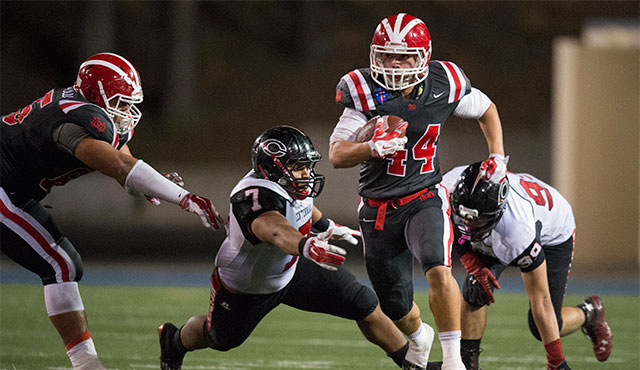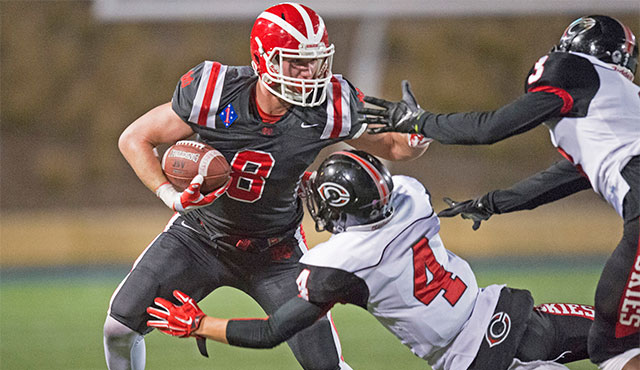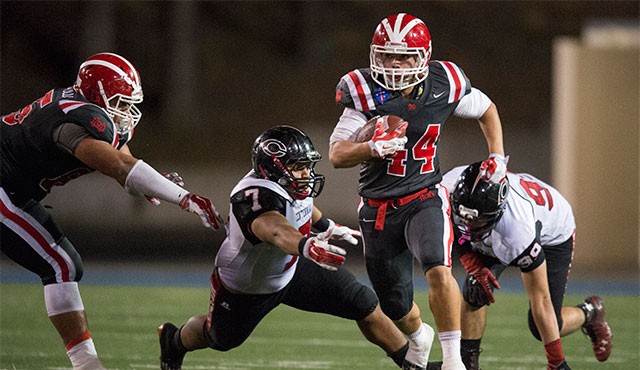The popularity of high school sports has never been greater than it is today. Not surprisingly, the competition and expectation levels have increased dramatically for the student athletes, coaches and trainers.
Athletes are training at an earlier age and the experience has its rewards and its drawbacks.
Greg Vandermade is the strength and conditioning coach at Mater Dei High School and is responsible for establishing training programs for more than 1,000 student athletes there. Part of his job includes structuring training guidelines to educate the athletes and improve their strengths while lowering their risk of injuries.
“Each athlete is given a regimen of lifting and stretching,” says Vandermade. “We tier to the freshman, JV and varsity skill levels and scale it to the athlete’s sport. I want our athletes to be ‘brilliant at the basics.’
“Some kids are more developed than others and the training program is geared toward each individual’s ability and it is dictated, monitored and recorded—it keeps them accountable.”
Kiki Mendoza, an assistant football coach at Mater Dei and former head coach at Bellflower’s St. John Bosco High School, said that high school athletes have taken training to a new level.
“The football programs I’ve been involved with always have had certified strength and conditioning coaches that properly train the athletes. However, most high schools cannot afford that luxury.”
Mendoza says that it’s not unusual for athletes to go to a fitness club after their school workouts and some have even hired personal trainers.
“It comes down to finances and the haves and have nots,” Mendoza says. “Some families can afford scientific-based training but it comes at a premium. These kids work out and are benchmarked and monitored with very specific goals in mind.
“The have-nots are obviously the kids who can’t afford extra training. The separation between the two is growing greater and there are times when these kids go up against each other in competition and it is dangerous. It takes seasoned coaches, officials and administrators to recognize when a team is outmatched and the safety of the kids is at risk.”
Vandermade emphasizes that overtraining also can be a problem.
“Typically athletes look in the mirror and only want to train what they can see, the upper body,” Vandermade adds. “We also concentrate on the lower body, including the legs to provide a muscular balance.”
Todd Norman is a personal trainer and owner of Cutting Edge Sports Training in Rancho Santa Margarita. He has worked with various JSerra and Santa Margarita high school sports teams, as well as athletes from Mater Dei and Servite.
“I start by teaching the athlete the basics of flexibility with a specific goal,” says Norman, who holds a master’s degree in kinesiology from Cal State Fullerton and was the Anaheim Ducks strength and conditioning coach from 1997 to 2000. His impressive client list includes NFL quarterback Mark Sanchez and tennis legend Lindsay Davenport.
“I focus on the physical, mental and nutritional aspects of training,” Norman says. “The athletes learn to train correctly and it leads to overcoming adversity and gaining confidence. I want the athletes to avoid injury, so I train them to enhance performance and mobility.”
JSerra High School baseball coach Brett Kay says an athlete’s evaluation begins the first time he sees the athlete.
“As coaches, we have to assess how much training the athletes have had as soon they show up,” says Kay. “We never know what we are going to get. We start our assessment the first time they walk on the field.
“It is a fun challenge. The maturation process is gigantic for high school kids and every kid is different. A kid can come in here and be a short and stubby 14-year-old but by the time he leaves he’s 6-3, 195 pounds and he’s a ‘horse.’”
Mendoza cautions that there are some training trends that can be troubling.
“Unsupervised training and kids taking supplements are highly discouraged,” Mendoza says. “Short-term heavy lifting is a recipe for injury and long-term chronic problems. As a coach we should be teaching life-long health benefits.“
Norman note that another common problem is that athletes don’t give their bodies enough time to recover, and that can lead to injury.
Kay says that today one of the down sides of being a young athlete is the tendency of some athletes to focus on just one sport.
“I think kids should play multiple sports because they will help each other,” Kay stresses. “Some kids play only one sport and train just for that one sport. A ‘what’s-in-it-for-me’ attitude develops because they have lost that ‘team’ sport concept.”



